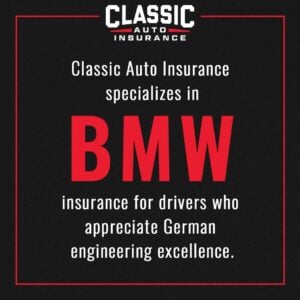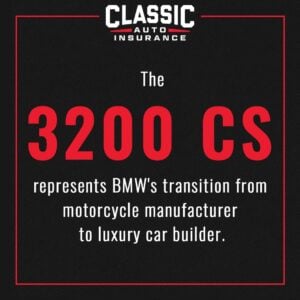Get a Quote
Home » Insurance for Classic & Collector Cars » Luxury Car Insurance » BMW Insurance
BMW Insurance
 Classic Auto Insurance specializes in BMW insurance for drivers who appreciate German engineering excellence. Whether you drive a classic BMW or a modern plug-in hybrid, our car insurance policies offer the coverage and security your luxury vehicle deserves.
Classic Auto Insurance specializes in BMW insurance for drivers who appreciate German engineering excellence. Whether you drive a classic BMW or a modern plug-in hybrid, our car insurance policies offer the coverage and security your luxury vehicle deserves.
We understand that BMW drivers need specialized protection, which is why we create customized insurance that cover everything from vehicle repairs to total loss situations.
We serve drivers across multiple states and adapt our coverage to meet local requirements while providing consistent service quality. We offer peace of mind through comprehensive BMW coverage options.
Contact us today for a quote at 888-901-1338, and learn about our discounts, claims process, terms, and conditions.
BMWs We Insure
There are some BMW vehicles we cover, though these aren’t the only BMWs that we underwrite.
1962 3200 CS
 This elegant grand touring coupe was BMW’s flagship model in the early 1960s, featuring a 3.2-liter V8 engine producing 160 horsepower. With only 603 units produced, the 3200 CS represents BMW’s transition from motorcycle manufacturer to luxury car builder.
This elegant grand touring coupe was BMW’s flagship model in the early 1960s, featuring a 3.2-liter V8 engine producing 160 horsepower. With only 603 units produced, the 3200 CS represents BMW’s transition from motorcycle manufacturer to luxury car builder.
Its distinctive Bertone-styled bodywork and sophisticated engineering made it a precursor to the legendary BMW coupes that followed. Our auto insurance for this rare model accounts for its limited production numbers and collectible status, offering agreed value policies that protect your vehicle as the value continues to increase.
M1 E26
The legendary M1 remains BMW’s only mid-engine supercar, produced from 1978 to 1981 with just 456 cars built. Powered by a 3.5-liter inline-six engine giving out 277 horsepower, the M1 was originally conceived for Group 5 racing homologation.
High Value
Its Giugiaro-designed wedge shape and racing pedigree make it one of the most valuable BMWs ever produced, with pristine examples commanding seven-figure prices. We provide specialized insurance policies that recognize this vehicle’s extraordinary value and unique maintenance requirements, with options for track events and concours participation.
M3 Cabriolet E93
 This fourth-generation M3 convertible (2007-2013) combined open-air driving with the performance of BMW’s naturally aspirated 4.0-liter V8 engine, producing 414 horsepower. The E93’s retractable hardtop mechanism offered both coupe-like rigidity and convertible freedom.
This fourth-generation M3 convertible (2007-2013) combined open-air driving with the performance of BMW’s naturally aspirated 4.0-liter V8 engine, producing 414 horsepower. The E93’s retractable hardtop mechanism offered both coupe-like rigidity and convertible freedom.
Last of Its Kind
As the last naturally aspirated M3, these cars have become increasingly desirable among enthusiasts who appreciate the high-revving V8’s character.
Our BMW coverage accounts for this complex convertible mechanism and ensures comprehensive protection for both the powertrain and sophisticated roof system.
Performance History of BMW
BMW’s racing heritage drives its legendary performance reputation. From Formula One victories to dominating touring car championships, BMW has proven its engineering excellence on tracks worldwide.
Off-Track
 BMW’s motorsport success directly translates to road cars, creating vehicles that drivers can showcase both on the street and track. Many BMW owners purchase models specifically for their proven performance capabilities, knowing these cars deliver exceptional experiences mile after mile.
BMW’s motorsport success directly translates to road cars, creating vehicles that drivers can showcase both on the street and track. Many BMW owners purchase models specifically for their proven performance capabilities, knowing these cars deliver exceptional experiences mile after mile.
The iconic BMW M1 is the trademark of the company’s supercar credentials of the late 1970s, combining racing technology with road-legal engineering. This tradition continued with the M3, which dominated touring car racing while providing thrilling performance for everyday drivers.
Racing Legacy
BMW’s involvement in Formula One, World Touring Car Championships, and endurance racing like the 24 Hours of Nürburgring has created a legacy of innovation that benefits every model in the series. Whether you opt for a classic BMW model or a late model BMW, this racing heritage adds long-term value.
Modern Era
 Modern BMW car’s performance extends beyond traditional gasoline engines to include cutting-edge electric and plug-in hybrid powertrains. The i8 demonstrated that environmental responsibility doesn’t require sacrificing performance, while M models continue pushing boundaries with advanced turbocharging and all-wheel-drive systems.
Modern BMW car’s performance extends beyond traditional gasoline engines to include cutting-edge electric and plug-in hybrid powertrains. The i8 demonstrated that environmental responsibility doesn’t require sacrificing performance, while M models continue pushing boundaries with advanced turbocharging and all-wheel-drive systems.
BMW’s racing-derived technology, including sophisticated suspension systems and aerodynamics, ensures these cars maintain their performance edge whether you’re navigating city streets or enjoying spirited country road driving. In addition to performance benefits, these innovations keep BMW at the forefront of automotive technology.
Whether you drive a classic BMW, or a new vehicle model, call us to learn about our discounts, conditions, and any exclusions that may apply: 888-901-1338.
How Credit Score Affects a BMW Auto Insurance Quote
Your credit score significantly impacts your insurance premium, with rates varying by hundreds of dollars annually, based on your score. BMW drivers with excellent credit (750+) typically pay 20-40% less than those with poor credit (below 580).
When you apply for BMW coverage, insurers use credit-based insurance scores that consider payment history, debt levels, and account age to determine risk and underwrite your policy.
Most states allow insurers to apply credit information when calculating insurance premiums, though some limit its impact. If you have less-than-perfect credit, focus on simply making payments on time to improve your rates and future eligible discounts.
Get Premium BMW Protection Today
Classic Auto Insurance understands that insuring your BMW requires specialized knowledge and insurance options. Our policies provide the peace of mind and flexibility you need to drive confidently. We have insurance policies tailored to meet your needs and budget, with options to add coverage for modifications and track use. We ensure you understand the process when you file a BMW accident claim, subject to select terms and conditions in your state.
Our Difference
 When ready to experience specialized BMW coverage, contact Classic Auto Insurance to start the process. Our insurance team will work with you to create a policy offering competitive services and rates. Only pay for access to the insurance services you need for the life of your BMW or other sports car.
When ready to experience specialized BMW coverage, contact Classic Auto Insurance to start the process. Our insurance team will work with you to create a policy offering competitive services and rates. Only pay for access to the insurance services you need for the life of your BMW or other sports car.
Live your passion for these German engineering trademarks while knowing you’re covered by comprehensive protection subject to applicable account discounts.
Call to speak with insurance professionals who can help you determine the perfect solution that meets your service requirements and provides the protection your BMW deserves in case of a claim.
Contact us today to receive information about our insurance services for BMW drivers: 888-901-1338. At Classic Auto Insurance, we’ve got you covered, insuring the flagship 1960s series models to the latest plug-in hybrid.

